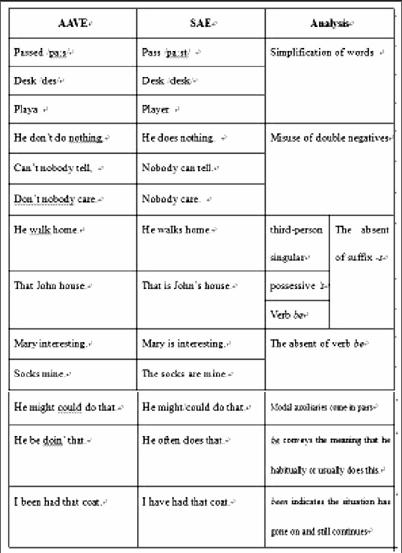African American Vernacular English
陈力


Abstract:African American Vernacular English (AAVE) is an African Americanvariety of American English. It is wildly used in different areas all through the country. In order to help people understand it better, the author studied the origin and development of this variety, and compared it with standard English.
Key words:AAVE; dialect; Creole
From the table above, we can have a general idea of AAVE. Its obviously that SAE is still the core of AAVE, however, there are many different rules in the later. On the one hand, not all African Americans speak AAVE.
2. Analysis
2.1 Dialect Hypothesis and Creoles Hypothesis
The origin of AAVE is still a matter of debate. There are two main hypotheses about the origin of AAVE. One is the dialect hypothesis and the other is the creole hypothesis.
Dialect is defined in Topic in Language and Culture for Teachers like this: “every country has a number of dialects, based on accent, word choice, and grammar” (P19).
Ordinarily, a country has only one standard language, so most of dialects are seemed to be nonstandard languages. The dialect hypothesis emphasize that AAVE is a nonstandard variety.
The Creole hypothesis maintains that modern AAVE is the result of a creole derived from English and various West African Languages. Slaves, were often thrown together during their passage to the New World. To be able to communicate with others, they developed a pidgin by applying English and some West African vocabulary to the familiar grammar rules of their native tongue. This pidgin was passed on to future generations, and classified as a Creole.
In my opinion, the formation of a language is a long and complicated process. Factors contribute to the formation are neither simple nor singular. Both of hypothesizes above include the reasons of AAVEs formation.
2.2 Code Switching and bidialectal
AAVE survived as a result of isolation from Standard American English— through marginalization from and by mainstream society. Still, most speakers of AAVE are bidialectal, that is to say, they can speaker, or at least, understand both AAVE and SAE. They adapt different languages depending on the targets and situations. For example, a black child may speak AAVE to his families at home, but use SAE at school. Maybe his parents can understand both AAVE and SAE, so when he speak to his parents, he uses both AAVE and ASE at the same time. This method of linguistic adaption two or more languages or dialects within a single conversation is called code switching. (Brown, P99)
2.3 Assimilation
In the chapter 7 of Topic in Language and Culture for Teachers, its said that “Assimilation is the adoption of another culture by choice or necessity”. Assimilation can be measured on four primary benchmarks. They are socioeconomic status, spatial concentration, language attainment, and intermarriage. As all know, African Americans were transmitted to Europe as slaves at the very beginning. At that time, they had their own language which cant be understand by white slave owner. However, few African American uses the language of their ancestors in todays American society. They were assimilated by American culture, and adapt their language. So AAVE, as a variety of SAE, is a reflection of culture assimilation.
【Bibliography】
[1] Brown, S., & Eisterhold J. Topic in language and culture for teachers[M]. Michigan: The University of Michigan Press, 2004.

